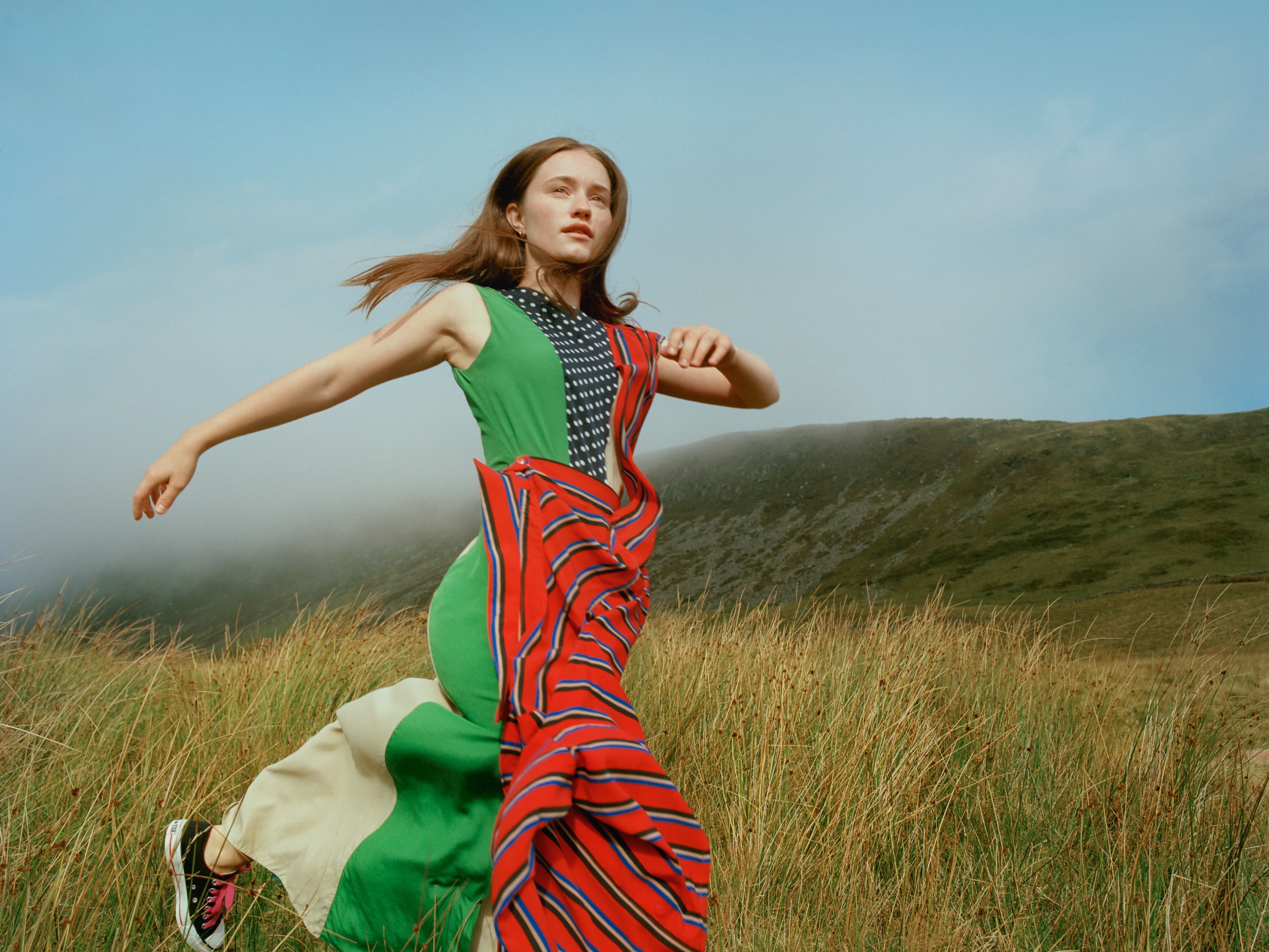Sigrid: ‘It is scary to be that vulnerable’
The singer-songwriter goes on an odyssey with Patrick Smith in Oslo and London to talk about writing songs that mean something, winning the approval of William and Kate, why there’s no excuse for not having women on festival line-ups, and ‘janteloven’


Your support helps us to tell the story
From reproductive rights to climate change to Big Tech, The Independent is on the ground when the story is developing. Whether it's investigating the financials of Elon Musk's pro-Trump PAC or producing our latest documentary, 'The A Word', which shines a light on the American women fighting for reproductive rights, we know how important it is to parse out the facts from the messaging.
At such a critical moment in US history, we need reporters on the ground. Your donation allows us to keep sending journalists to speak to both sides of the story.
The Independent is trusted by Americans across the entire political spectrum. And unlike many other quality news outlets, we choose not to lock Americans out of our reporting and analysis with paywalls. We believe quality journalism should be available to everyone, paid for by those who can afford it.
Your support makes all the difference.Outside a small nightclub in Oslo, the rain cascading down, a young woman is being turned away at the door. The event, celebrating Norway’s music scene, is at capacity, she’s told. A man nearby pipes up, laughing incredulously: “But she is Music Norway.” Five minutes later, her entry negotiated, she’s at the bar, surrounded by a swarm of immaculately coiffed musos, each clamouring to buy her a drink. The young woman, dressed in a grey hoodie and jeans, is Sigrid, Norway’s biggest ever pop export.
Blending a swooping falsetto with winsome melodies, skyrocketing choruses, chattering synths and lyrics grounded in authenticity, her sound is a demitasse of peppy pop. She’s had a platinum-selling single, almost 1.5 billion streams, sold-out tours and is now a regular fixture at Glastonbury Festival. While, yes, she can still walk around unrecognised in London, it’s a different story in the Norwegian capital, the 25-year-old tells me the next day. “I’ll be at the grocery store and I’m buying toilet paper and people will ask for a selfie. I’m like, maybe not now, but, sure.”
It’s a bit surprising because, she points out, Norwegians are quite reserved, not really ones for celebrity culture. They even have a word for it. “Janteloven,” says Sigrid, “is the culture of, like, you shouldn’t walk around thinking you’re better than anyone.” We could all do with a shot of that, I reckon. Perhaps it’ll catch on like hygge, the Danish concept of cosiness that knitted itself into the cultural zeitgeist in 2016 and was used to sell everything from cashmere cardigans to yoga retreats.
Anyway. We’re in Sigrid’s flat in a bosky area of Oslo, a few months before the release of her exceptional second album, How to Let Go. A wall of shoes climbs the corridor; in the corner of the yellow living room sits a beautiful white Yamaha piano (“My favourite thing in my home”). There’s a framed letter from Prince William. “I was invited to perform with the Norwegian royal family at their castle because they had Prince William and Kate, the Duchess of Cambridge,” says Sigrid. “At the time, I was just so unaware of being an artist or how you are supposed to be in that type of environment. I showed up and it was really cool, and I started to sing. I was honestly s***-faced nervous but I was thinking I have to treat it as a performance.”
Afterwards, Sigrid recalls frantically plugging her breakout song “Don’t Kill My Vibe”, a defiant call to arms about music industry sexism, to each and every person there. The Duke and Duchess of Cambridge were particularly encouraging. “They were so lovely,” she says. “So I invited them to my Shepherd’s Bush show and of course they couldn’t come. But they sent a lovely note. It was like, ‘We can’t make it to the show but thanks for inviting us,’ and then Prince William signed at the bottom of the letter: ‘I have downloaded the album.’” It was 2017 and the album William was referring to was in fact Sigrid’s four-track EP, Don’t Kill My Vibe, the driving force behind her topping the BBC’s Sound of 2018.
In person, Sigrid is sort of how you’d imagine: polite, sweet-natured, with a tendency to greet questions with a neat “Mm-hmm, yeah”. Just as she commands the stage, a wholesome blast of charisma – skipping, hopping, shimmying – so she’s the perfect convivial host, self-effacing and solicitous. There are fresh Norwegian pastries; she grinds coffee for us, then fetches a ladder to reach the mugs.
By her own admission, Sigrid finds it difficult to speak about herself – and is a little nervous once the Dictaphone is turned on. Take our conversation about #MeToo. While comfortable saying the music industry is due its reckoning, she finds it “difficult to respond eloquently sometimes in interviews. We look for snappy quotes,” she explains, “and it’s hard to do that with #MeToo.” Growing up in the west coast harbour town of Ålesund, she was, in her words, “always the quiet one around the table when my family were discussing things like local politics. I was the youngest sibling sitting in the corner just soaking it up… I don’t like to talk about something if I don’t feel like I know enough about it. So I don’t mean to shy away from the off-music topics because I do really believe that, with the platform you have as an artist, it’s really important to use it,” she continues. “I just don’t always have the answer.”
That said, ever since “Don’t Kill My Vibe” famously clapped back at two music producers who once patronised her, she has no qualms fighting her corner and calling people out. “I was in a [songwriting] session a while ago,” she recalls. “I wanted to play the piano and I was just told to ‘stick to what I’m good at’: my melodies and lyrics. It was hurtful but I feel like I’ve gone through that before, being underestimated. So I was like, ‘Mm-hmm, yeah, no. I’ve played piano for 10 years and I’m going to keep doing it.’” Generally, though, there’s a little “tiptoeing” around her, she says.
A few months later, the week before her new album’s release, Sigrid and I meet again, this time at a bowling alley in north London. She’s excited, not just because, hey, we’re bowling, but because she’s got wind of the fact that her face will be plastered on a huge billboard in New York’s Times Square. “I f***ing love being on billboards,” she says, eyes gleaming. “It’s amazing. It’s great. It’s an honour.”
Enjoy unlimited access to 100 million ad-free songs and podcasts with Amazon Music
Sign up now for a 4 month free trial (3 months for non-Prime members)
Enjoy unlimited access to 100 million ad-free songs and podcasts with Amazon Music
Sign up now for a 4 month free trial (3 months for non-Prime members)

It turns out this is the third time in as many weeks that Sigrid’s been to these lanes. There are strikes. Spares. Splits. In denim dungarees and hoodie, Converse sneakers and a Neil Young baseball cap, she looks like she’s been practising this for years in a dustbowl town in Seventies America. The hat partially conceals long, poker-straight hair. Vacillating between agony and elation, she admits she’s “competitive in things where I think I have a chance at being good”.
We order a giant pepperoni pizza and I’m whisked through Sigrid’s timeline. The shy eight-year-old who found confidence after playing “the f***ing king” in a school play. Skiing. Her inability to play other sports. Her elder brother Tellef, a skilled musician just finishing a PhD in media sociology on newspaper economy at Cambridge. Her sister Johanne, an “amazing” singer now working in Madrid at a live concerts company. Being taught the piano by her grandmother. Falling for Adele, Coldplay and Muse. Discovering Joni Mitchell. The time she turned down the chance to play Oslo’s by:Larm Festival, an internationally renowned celebration of Nordic musical talent, because she didn’t feel ready.
“I just knew I could do better than the songs that I had,” she says now. “It was a massive window to show yourself and get signed, but I was like, ‘I know that I can do better,’ and I came back a couple of years later and I’d written ‘Don’t Kill My Vibe’, and it felt so f***ing right to be on the stage, because I had that gut feeling and confidence to know when I’m not being as good as I think I can be.”
I just knew I could do better than the songs that I had
That self-confidence percolates through How to Let Go, the follow-up to her 2019 debut Sucker Punch. Distilling aspects of folk, indie-rock and nu-disco into vignettes of mid-twenties life, it fizzes and pops in all the right places. Lead single “Mirror”, a self-empowerment anthem swathed in synths, finds Sigrid buoyantly belting out “I love who I see looking at me”, while “A Driver Saved My Life” is a glitterball paean to hearing banging tunes in the back of a cab. There’s also “Bad Life”, a duet about mental health with Sheffield pop-metallists Bring Me the Horizon, and “Burning Bridges”, an exhilarating break-up song in which she sings “I tried to wave a white flag, but you set it on fire”. In The Independent’s four-star review, Roisin O’Connor wrote, “Sigrid achieves exactly what she’s set out to do: add some grit to her previously pristine pop.”
The record, says Sigrid, is “about letting go of the insecurities that you get along the way. A growth thing. ‘Mirror’, for example, is about accepting who I am as a person, accepting my independence, accepting if I was a bit stupid... stuff like that. It is scary to be that vulnerable, but I don’t want to sing songs if it doesn’t mean something to me.”
As well as an exercise in taking control, How to Let Go feels like a response to the critics who questioned her verisimilitude. For some, that white T-shirt and jeans uniform felt like a major label marketing strategy. It absolutely wasn’t, insists Sigrid. “I just feel really nice in jeans and a T-shirt. I just feel like I never go wrong with it and it’s one less thing to think about. I definitely got to a point where I read some articles saying it’s a marketing plot and it’s not real and I almost started to think, ‘What did I not do this by myself?’ But then, I thought no: I’m not going to let anyone tell me how I should be or behave. I know it’s me and what I’m comfortable in. I love to dress up when there’s time for it. I love make-up, but I have sensitive skin. I can’t wear a lot of it because my skin reacts to it.”

I wonder why male artists such as Ed Sheeran, whose general aesthetic is jeans and T-shirt, don’t attract the same scrutiny. “I can’t speak on behalf of him and I don’t think it’s easy for anyone being an artist and being in the public eye even if you’re a girl or a guy or anything,” she says. But… “I definitely felt a bit like, why am I being asked so much about what I’m wearing? I genuinely think the most interesting thing about me is my songs.”
Does she care what people think? “I do, yeah,” she replies. “It does get to me.”
Not that the scepticism has affected her career too much. This summer, she’s playing Isle of Wight, Glastonbury and Reading, the three biggest UK festivals. I mention how, even in 2022, so few female artists appear on the line-ups. “It just… it shouldn’t be hard,” she sighs. “There are so many talented women out there who could be on the line-up. I don’t think there’s really a big excuse.”
Later, over a pint, she tells me a funny story, about how when she was 17, she went to see a Mac DeMarco gig with her mates. “I was front row. I was so drunk. I was a fan.” After, she asked if she could have a photo taken with him. He said yes – “he was so lovely”.
But then a couple of years later, “I was playing Oya Festival [in Oslo] and look who’s there… Mac DeMarco. And as we passed each other, he was just like, ‘You’. And I thought, ‘Oh God, he recognises me as one of the fans asking for a photo.’ And he was like, ‘It’s you from the billboard.’” He’d been staying at a hotel in New York – “and every morning when he opened the window, he looked out at a billboard of me, of my face”. It was an ad for Apple Music.
If you wanted an image to sum up this janteloven popstar, that one would probably do.
‘How to Let Go’ is out now. She plays Standon Calling festival 21-24 July



Join our commenting forum
Join thought-provoking conversations, follow other Independent readers and see their replies
Comments